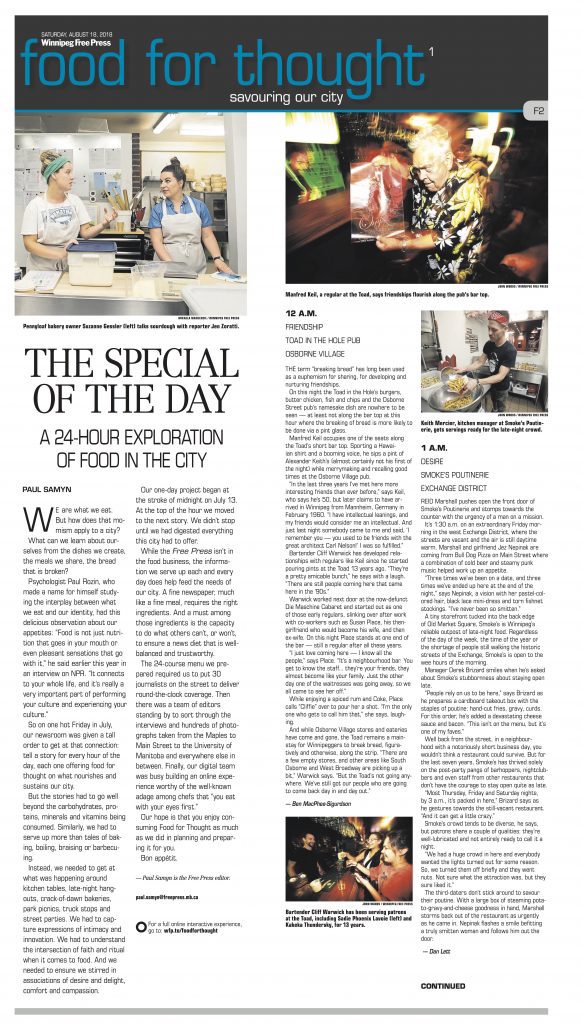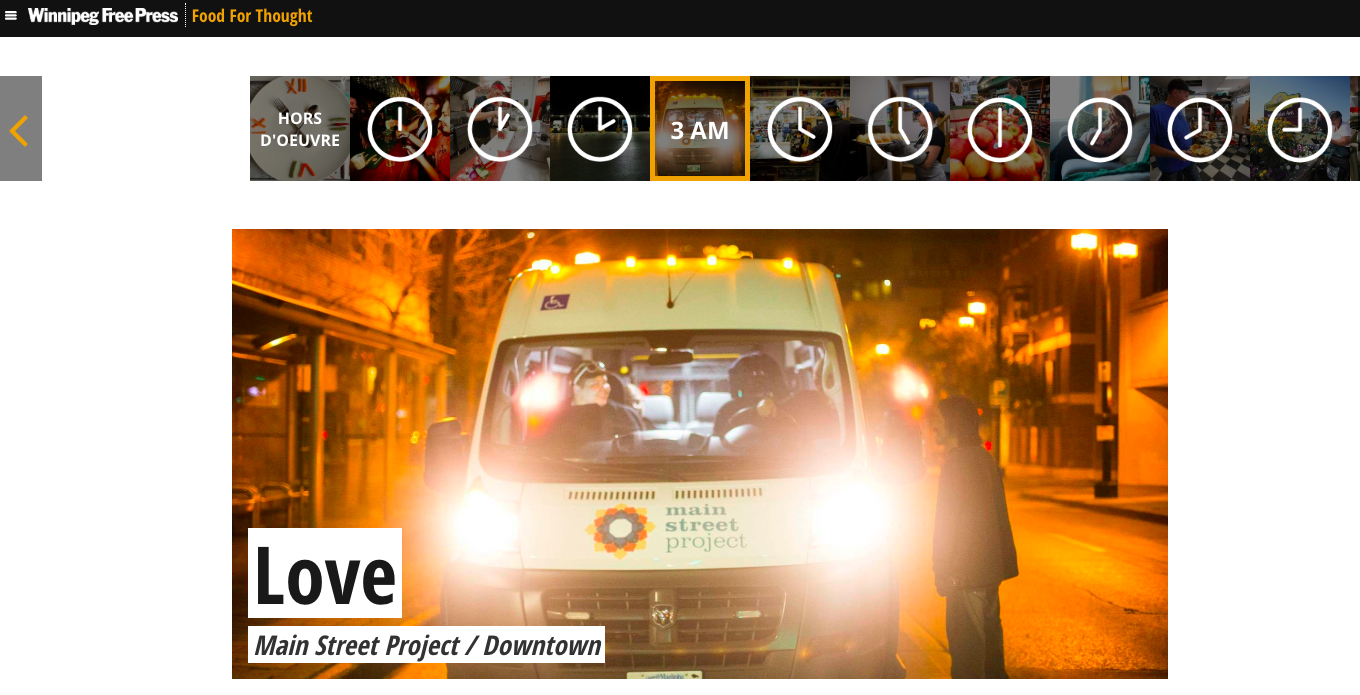In the early hours of July 13, Katie May was in downtown Winnipeg, much earlier then she’d normally be getting ready to cover courts for the Winnipeg Free Press.
She was following the Main Street Project, an organization that helps vulnerable communities in Winnipeg, as they handed out food, water and harm reduction supplies to homeless people throughout the downtown core. The 3 a.m. reporting time slot was one she actually had to beat out another reporter for. “I won out! And then I thought, what did I just get myself into?” May said.
She was one of 24 reporters, telling stories about Winnipeg over the course of 24 hours focusing on something everyone can relate to — food.
Posted online on Aug. 16, “Food for Thought” is a reporting project the Free Press has published outside of its paywall as both an experiment in storytelling and an effort to show their community how a newspaper binds them together. And community members are engaging with it – average reading time on the piece has been 19 minutes.

Free Press editor Paul Samyn was reading the New York Times Magazine in June when he saw its “Love City” project, which profiled 24 couples in New York City over a 24 hour period. He had been looking for a fun and engaging project for the summer months, which many editors know can be a quiet time for local news. “So I went, well that was kind of cool,” said Samyn. “(If) the New York Times can do it, then clearly the Winnipeg Free Press has to do it too.”
Wanting to differentiate their project from the Times’, Samyn and his editorial team wanted a topic that was as engaging as love. They landed on food. But this would be more than sharing recipes or restaurant recommendations. The true focus of this story is community connections, and so the editorial team endeavoured to cover as wide a swath of Winnipeg as possible. “So you get things at a truck stop at the west end of the city; you get at the south end a really intimate story about feeding people at an institution where there are some significant mental challenges,” he said. “We wanted to make sure that we could show to our readership that we are covering the city like no one else.”
Part of the challenge was getting all 24 slots covered, without interrupting the normal workflow of the newsroom. The editorial team had identified the target areas it wanted to address and what time reporters would head to the location. Staff — including sports reporters, arts reporters and editorial managers — were given the opportunity to sign up for spots they wanted — as it turned out, there was no issue filling any of them. “They are creative people,” said Samyn. “I don’t want what we do to ever become routine.” This was a chance for the whole newsroom to do something different.
Among the places the series took readers was: A mother’s living room while she breastfed her child; A food centre that creates nourishing meals for free; and a Jewish community centre for Shabbat dinner.
May was drawn to the early morning slot because of the challenge of finding a story at what is, for most, is an ungodly hour to be awake. “I knew I’d have to report whatever happened within the hour, so I wasn’t sure what kind of story I’d end up with, but I figured not all that many people experience Winnipeg at 3 a.m.anyway.” Her piece chronicled how the Main Street Project hands out food through downtown Winnipeg. “There is a lot of need in the city,” she said. “So if we’re talking about how food brings people together, I knew I didn’t want to overlook the more vulnerable perspective.”
The feature, which took less than a month, from the day it was reported to the day it was posted, to pull together, was lead in the newsroom by Scott Gibbons, associate editor of enterprise projects, and Wendy Sawatzky, associate editor of digital. They didn’t want to just run 24 stories — they wanted to showcase the visual components and give a sense of the timing that was a key part of the project.
Samyn said they decided not to post the feature behind a paywall because they wanted to make the feature available to everyone — an opportunity to put their best foot forward.
While summer traffic typically takes a dip for most news media websites, engagement has been good with this particular story. According to Samyn, the average time spent reading “Food for Thought” has been 19 minutes. “I don’t think we’ve ever really seen that level of engagement with anything we’ve done.”
With a municipal election coming in the fall, there may not be time for another project of this scope on the immediate horizon. But Samyn said it has been useful to understand that the newsroom can take on a project of this scope — and the lessons learned will be applied to news coverage in the future.
But the biggest thing to come out of the project is building connections with the community. “I think the important element of this project, and I think the challenge for newspapers, is to demonstrate what our newsroom can do and make the case that no one covers communities like newspapers,” he said.
After May filed her own piece, she took a quick nap and was back to her regular beat. She too had to wait to see what her colleagues had written and what the piece would look like as a whole. “It was fun for me to read all the 24-hour vignettes when the project went up,” she said. “I learned a lot from my colleagues’ reporting, showing all these different pieces of the city, knowing that we all kinda started from scratch with this idea and had to wait and see how it would turn out.”
H.G. Watson was J-Source's managing editor from 2015 to 2018. She is a journalist based in Toronto. You can learn more about her at hgwatson.com.

